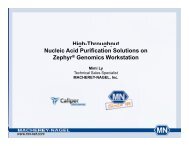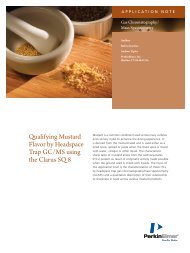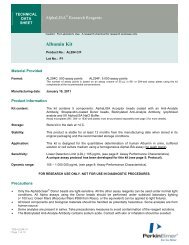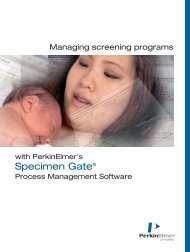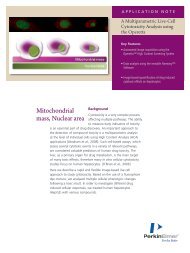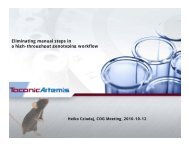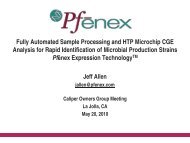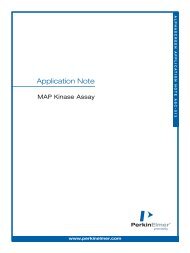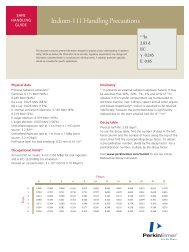AlphaLISA Assay Development Guide - PerkinElmer
AlphaLISA Assay Development Guide - PerkinElmer
AlphaLISA Assay Development Guide - PerkinElmer
You also want an ePaper? Increase the reach of your titles
YUMPU automatically turns print PDFs into web optimized ePapers that Google loves.
Table III: Microplates<br />
<strong>Assay</strong><br />
Format<br />
96<br />
384<br />
1536<br />
Microplate Catalog # § well<br />
Total<br />
volume<br />
Recommendations<br />
OptiPlate-96 6005290 400 µL Ideal for assay volume ≥ 50 µL<br />
½ AreaPlate-96 6005560 180 µL<br />
Ideal for assay volume of 50 µL in<br />
96-well format<br />
ProxiPlate-96 6006290 100 µL Not recommended<br />
OptiPlate-384 6007290 105 µL<br />
AlphaPlate-384 6005350 105 µL<br />
ProxiPlate-384 6008280 30 µL<br />
AlphaPlate-1536 6004350 12 µL<br />
OptiPlate-1536 6004290 12 µL<br />
§<br />
For 50 plates; refer to <strong>PerkinElmer</strong>, Inc. website for other quantities<br />
Good for assays of 25-50 µL in<br />
384-well format<br />
Ideal for high-count assays of 25-<br />
50 µL in 384-well format (lower<br />
cross-talk than OptiPlate-384)<br />
Good for assays of 10-25 µL in<br />
384-well format<br />
Ideal for assays of 5-10 µL in<br />
1536-well format (lower cross-talk<br />
than OptiPlate-1536)<br />
Not recommended for <strong>AlphaLISA</strong><br />
due to higher cross-talk<br />
The protocols included in this manual are for OptiPlate-384 microplates.<br />
Other plate types listed in Table III may be used with the appropriate assay<br />
volume.<br />
<strong>Assay</strong>s must be read using an AlphaScreen-compatible reader such as all<br />
EnVision ® multilabel plate readers with an AlphaScreen module, the Fusion-<br />
Alpha multilabel reader or the AlphaQuest ® original AlphaScreen reader<br />
(<strong>PerkinElmer</strong>, Inc.). The normal AlphaScreen settings should be used.<br />
II.<br />
INTENDED USE<br />
The <strong>AlphaLISA</strong> Acceptor beads are intended to perform biomarker<br />
detection (referred in this guide as analyte), protein-protein<br />
interaction, intracellular target detection assays or any other<br />
biological detection assay. <strong>AlphaLISA</strong> is for research purposes only<br />
and not for use in any diagnostic procedures.<br />
- 6 -



